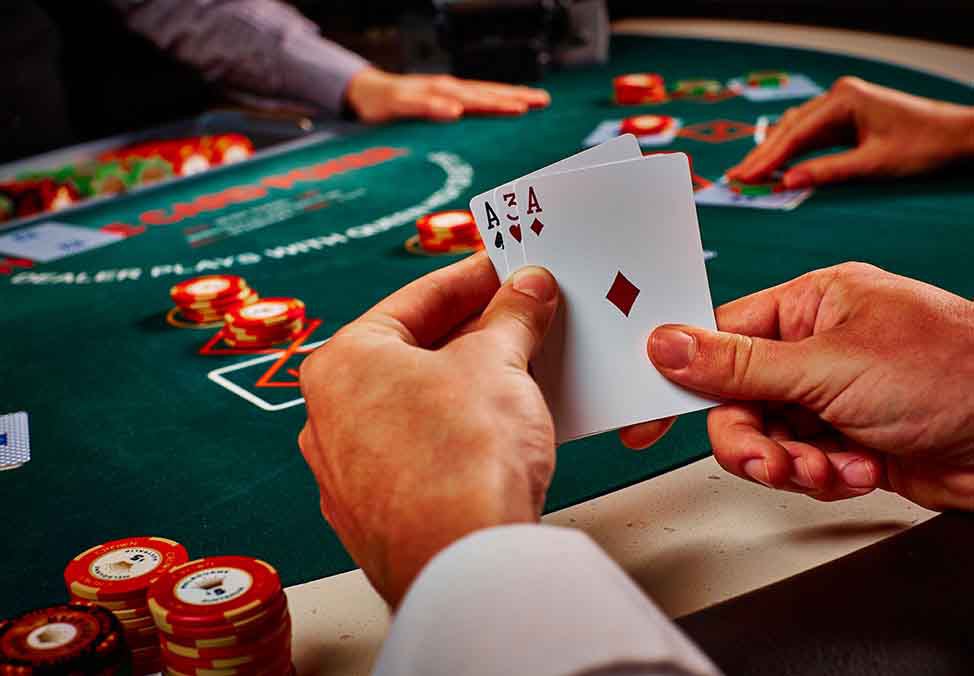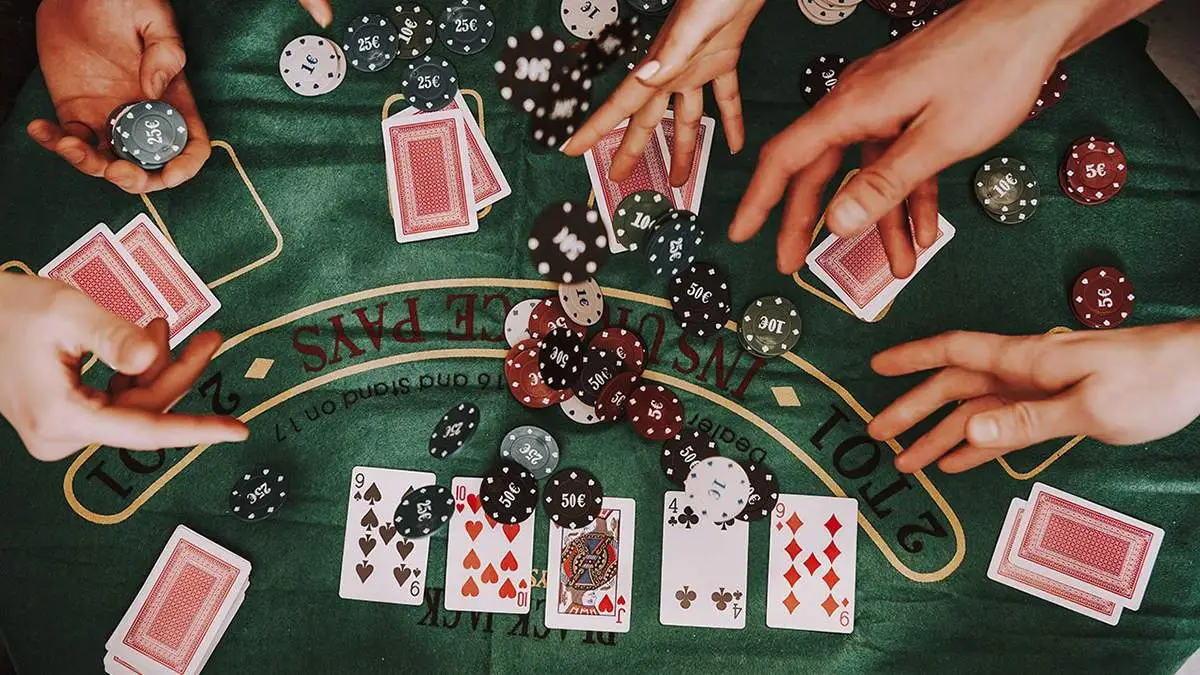Caribbean Poker is an exciting card game where you don’t compete against other players but directly against the dealer. This makes it an ideal choice for those seeking a fast-paced gambling experience without the complexities of traditional poker strategies. Forget about bluffing and poker faces – it’s all about your cards and understanding the simple rules. Are you ready to learn how to get started? Let’s dive into the basics of Caribbean Poker and explore how to play.
A complete analysis of the rules of Caribbean poker
Caribbean poker has a simple and logical structure. Here is a step-by-step guide on how the game works:
1. Initial bet (Ante)
Before the cards are dealt, you make a mandatory initial bet, which is called Ante. This is your entrance ticket to the game.
2. Card distribution
After the Ante bet is made, you and the dealer each receive five cards. Your cards are dealt face down (downside up). The dealer also has five cards, but one of them is face up, which means it is visible to you. This face-up card is a key element in making your next decision, as it provides some information about the strength of the dealer’s hand.
3. Your decision
After receiving your cards and seeing the dealer’s card, you must make one of two decisions:
- Fold (Fold): You decide to fold your cards. In this case, you lose your Ante bet and exit the current round of the game. This decision is made if your hand is too weak to compete with the dealer.
- Call (Call) / Play: You decide to continue playing. To do this, you must make an additional bet, which is usually twice your initial Ante bet. After that, you wait for the dealer to reveal his cards.
4. Revealing the cards and determining the winner
At this stage, the combinations are compared:
- Dealer’s Qualification: In order for the dealer’s hand to be “qualified” (i.e., to be included in the combination comparison), the dealer must have a combination of at least Ace-King (meaning that the dealer’s five cards must include at least an Ace and a King).
- If the dealer’s hand does NOT qualify (weaker than Ace-King): You receive a win based on your Ante bet (usually 1 to 1). Your additional bet (Call) is returned to you without a win. The combination of your hand does not matter in this case.
- If the dealer’s hand qualifies (Ace-King or higher): Your combination is compared to the dealer’s combination.
- If your hand is stronger: You win. Your Ante bet is paid out 1 to 1, and your Call bet is paid out according to the paytable (which depends on the strength of your hand, for example, a flush or straight may have a higher payout).
- If the dealer’s hand is stronger: You lose both your Ante and Call bets.
- If you and the dealer have the same hand (a draw): Both your Ante and Call bets are returned to you (a push).
Understanding these stages and making decisions based on the dealer’s open card is the key to successful Caribbean poker gameplay.
Caribbean Poker vs. Classic
 Differences:
Differences:
- In Caribbean poker, there is no trading between players, as there is only one opponent, the dealer.
- There is no opportunity to exchange cards, which makes the game more mathematically predictable.
- Bluffing is ineffective, as the opponent (the casino) makes decisions based on strict rules.
- Knowing the probabilities of winning combinations becomes a crucial tool for successful players.
Understanding these stages helps you feel confident at the table and apply conscious strategies in Caribbean poker.
Caribbean Poker Online: How the Game Works Online
Playing Caribbean poker online is more convenient than playing it in an offline casino. In real-time mode, you can choose a table with the desired limits, use a strategy, and enjoy the game without unnecessary pressure from other players.

In online casinos, speed of decision-making is important. There is no time to think about it for a long time, which creates additional difficulties. Many platforms offer a virtual money mode, allowing you to practice before betting with real money.

Advanced player tactics:
- Using probabilities. If you have a king-queen of different suits, a call bet may be risky, but if you have cards of the same suit, you have a chance to make a flush.
- Don’t overestimate weak hands. Cards like ace-nine may seem strong, but they often lose against a skilled dealer’s hand.
- Don’t play every hand. Caribbean poker is not a game where you need to participate in every hand. Proper hand selection increases your chances of consistent wins.
Unlike traditional poker, psychological techniques like bluffing do not work here. The whole strategy is based on mathematics and probabilities. The better a player is able to analyze his hand and possible scenarios, the higher the chance of winning.
How to play Caribbean poker with the greatest efficiency? The main thing is to stick to the strategy, study the pay tables and not make emotional bets.
Caribbean Poker: Combinations and Their Power
The strength of the hand determines the outcome of the game. In Caribbean poker, it is important not only to know the combinations of cards, but also to understand their probability of occurrence.
- Royal flush is the highest combination (from ace to ten of the same suit). The probability of occurrence is extremely low — 0.000154%.
- Street flush is a combination of five cards of the same suit, which occurs with a probability of 0.00139%.
- Four of a kind is four identical cards, which occurs approximately in 0.024% of cases.
- Full house is a combination of three identical cards and a pair. The chance is 0.1441%.
- A flush is five unrelated cards of the same suit, with a probability of 0.1965%.
- A straight is a sequence of five cards of different suits. The probability is 0.3925%.
- A three is three cards of the same value. The probability is 2.1128%.
- Two pairs have a probability of 4.7539%.
- One pair is the most common combination, with a probability of 42.2569%.
Understanding the prospects allows you to make more informed decisions during the game.
Now you know how to play Caribbean poker
 Knowledge of the rules, understanding of probabilities, and the right strategy will help you increase your chances of winning. Once you understand how to play Caribbean poker, you can feel confident at the table. The best way to try your luck and apply the tactics you’ve learned is by playing in an online casino.
Knowledge of the rules, understanding of probabilities, and the right strategy will help you increase your chances of winning. Once you understand how to play Caribbean poker, you can feel confident at the table. The best way to try your luck and apply the tactics you’ve learned is by playing in an online casino.
 en
en  de
de  ar
ar  es
es  hi
hi  fr
fr  nl
nl  it
it  pt
pt  el
el 









